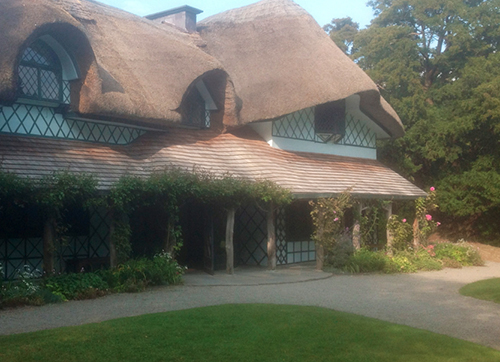The Swiss cottage in Ireland [Rogue Nomads]

This is part 26 of Dee’s grey nomad adventure around Europe. To read her previous instalment, click here
County Cork has a lot to offer the tourists, but we had booked for a house sit in Enniscorthy, and with two days spare, we decided to go via Cahir, with its castle (of course!), and other interesting historical sites.
We stayed at a site that was also an apple farm, and while we were there we received ‘free’ apple juice. Lovely. We arrived early, so went to check out the castle straight away. It was once again a warm sunny day, the castle is in the centre of the town, you can’t miss it, and as members of English Heritage we didn’t have to pay the entry fee. The tour was great, lots of stairs, and as I’m not a lover of heights I just let Greg go up on to the roof. It’s a castle well worth visiting, and in good condition. The oldest part, the Keep, is 13th Century; owned by the Butler family from 1375, who fortified it even more. It was attacked and there’s still a cannonball high up on one of the walls.
Along the river by the castle, there’s a one mile walk to the Swiss Cottage. We arrived just before closing time, and were the last to have the tour. The image of the cottage frequents guide books for Ireland, but the interior is not – photography is not allowed. Built in the 1800s by John Butler, a descendant of the original owner of Cahir Castle; the cottage has a deliberately rustic look. Apparently, it was the ‘in thing’ in those days to ‘play’ at being peasants.
Marie Antoinette was one of the first to start this fad. The exterior has a beautiful thatched roof, recently rethatched at a cost of €100,000, with the woodwork looking like branches of trees. Inside the theme is continued. The Butlers used to go there for peasant themed picnics. They lived in the castle so it was a short distance away. Although there were bedrooms, they never stayed the night. After it was sold a big family of caretakers lived in it. Once this family left, a Canadian woman bought it for €30,000 with the intention of having it as a holiday home, but maybe she died, as nothing happened and for six years it became a home for squatters, and locals used and abused it. The government took it over and it’s now in the care of Irish Heritage.
Obviously, they had no idea what peasant life was like!
Have you visited any home/cottage of historical heritage? What are favourite travelling adventures? Tell us more below!









 Proudly Australian owned and operated
Proudly Australian owned and operated